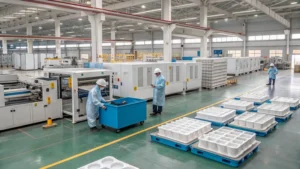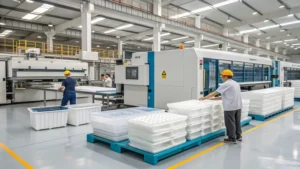
Deciding whether to thermoform or injection mold your plastic part1 hinges on understanding your project’s needs—part size, complexity, production volume, and budget all play a role. Thermoforming2 heats a plastic sheet and shapes it over a mold, making it great for large, simple parts with low to medium runs. Injection molding, on the other hand, injects molten plastic into a mold under high pressure, excelling at small, intricate parts with high production volumes.
Thermoforming is ideal for large, simple parts with lower volumes, while injection molding3 suits small, complex parts with high precision and scalability.
This guide breaks down both processes, exploring their applications, pros and cons, workflows, and design considerations to help you choose the best method for your part.
Thermoforming is always cheaper than injection molding.False
Thermoforming has lower upfront costs, but injection molding becomes more economical for high-volume runs due to lower per-part costs.
Injection molding offers tighter tolerances than thermoforming.True
Injection molding’s precision makes it ideal for parts requiring exact specifications.
- 1. What is Thermoforming and Injection Molding?
- 2. How Do Thermoforming and Injection Molding Differ in Applications?
- 3. What are the Pros and Cons of Thermoforming vs. Injection Molding?
- 4. What are the Key Steps in Thermoforming and Injection Molding?
- 5. How Do Materials Affect Thermoforming and Injection Molding?
- 6. What Design Considerations Should I Keep in Mind?
- 7. How Do I Decide Between Thermoforming and Injection Molding?
- 8. What Related Technologies Should I Know?
- 9. Conclusion
What is Thermoforming and Injection Molding?
These two processes transform plastic into functional parts, but their methods and outcomes differ significantly.
Thermoforming shapes heated plastic sheets over a mold, while injection molding fills a mold with molten plastic under pressure.

Thermoforming
Thermoforming heats a thermoplastic sheet until it’s pliable, then uses vacuum or pressure to form it over a single-sided mold. Once cooled, the part is trimmed to its final shape. It’s perfect for large, shallow items like packaging trays, automotive panels, and signage.
Injection Molding
Injection molding melts plastic pellets and injects them into a two-sided mold under high pressure. After cooling, the part is ejected, revealing intricate details and tight tolerances. It’s the go-to for small, complex parts like electronic housings and medical components.
Thermoforming can’t handle complex designs.False
It excels with simpler shapes but can manage moderate complexity with advanced mold designs.
Injection molding is only for tiny parts.False
While it shines with smaller items, larger parts are possible with the right setup.
How Do Thermoforming and Injection Molding Differ in Applications?
The right process depends on what you’re making and where it’s headed.
Thermoforming shines in large-scale, simpler applications like trays and panels, while injection molding dominates precision-driven fields like electronics and medical devices.
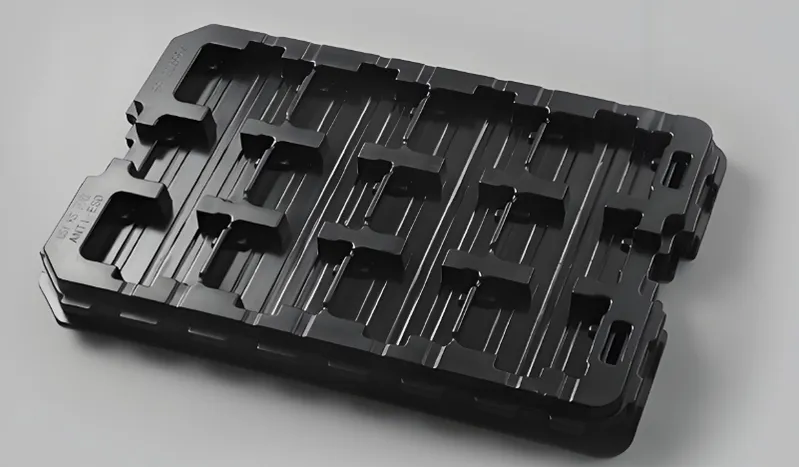
Thermoforming Applications
-
Automotive: Dashboards, interior trim.
-
Packaging: Blister packs, food trays.
-
Signage: Large displays.
-
Medical: Trays, non-precision housings.
Injection Molding Applications
- Consumer Electronics: Phone cases, appliance parts.

-
Automotive: Clips, connectors.
-
Medical Devices: Syringes, surgical tools.
-
Toys: Detailed figures, game pieces.
Thermoforming leads in medical precision parts.False
Injection molding is preferred for precision medical components due to its accuracy.
Injection molding is key for high-volume goods.True
Its consistency and speed suit mass production.
What are the Pros and Cons of Thermoforming vs. Injection Molding?
Each process has strengths and trade-offs that impact your decision.

Thermoforming offers low startup costs and quick turnarounds, while injection molding delivers precision and cost efficiency at scale.
| Factor | Thermoforming | Injection Molding |
|---|---|---|
| Volume | Best for 250–5,000 parts | Ideal for 5,000+ parts |
| Tooling Cost | Low (aluminum molds) | High (steel molds) |
| Lead Time | 6–12 weeks total | 12–24 weeks total |
| Per-Part Cost | Higher at scale | Lower at scale |
| Complexity | Simple to moderate shapes | Complex, precise shapes |
| Material Waste | Trimmable, reusable excess | Runner/gate waste, recyclable |
| Material Variety | Sheet plastics (PP, PET) | Wide range (ABS, PC, nylon) |
Thermoforming Pros
-
Affordable tooling.
-
Fast setup and production.
-
Great for large, simple parts.
-
Minimal waste with reusable trimmings.
Thermoforming Cons
-
Costly per part in high volumes.
-
Limited to sheet plastics.
-
Less precision for intricate designs.
Injection Molding Pros
- High accuracy and repeatability.

-
Broad material options.
-
Economical for large runs.
-
Handles complex geometries.
Injection Molding Cons
-
Expensive initial tooling.
-
Longer lead times.
-
Higher waste from runners/gates.
Thermoforming is always quicker.False
It’s faster for small runs, but injection molding speeds up at scale once tooled.
Injection molding supports more materials.True
It accommodates a wider array of thermoplastics, including high-performance ones.
What are the Key Steps in Thermoforming and Injection Molding?
Knowing how each process works helps you anticipate challenges and optimize results.
Thermoforming heats, forms, cools, and trims, while injection molding melts, injects, cools, and ejects.
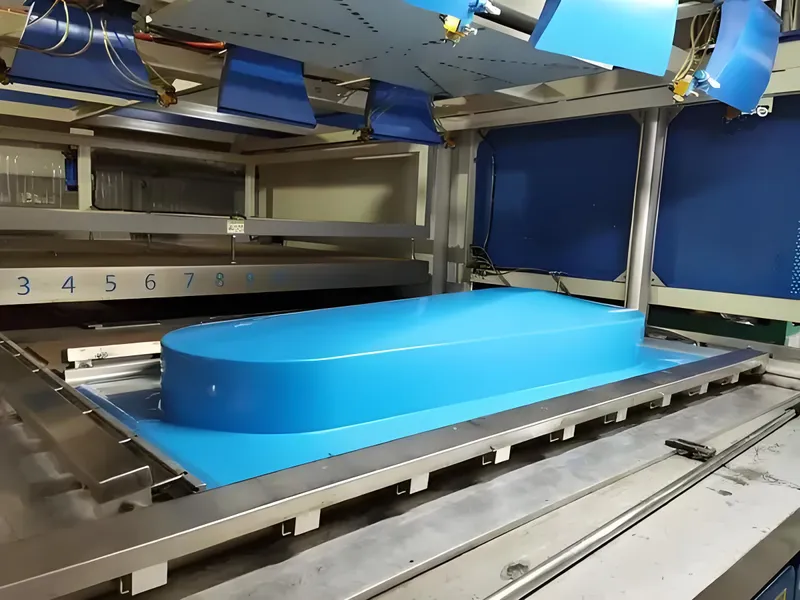
Thermoforming Steps
-
Heat Sheet: Warm a plastic sheet (e.g., PET) until pliable.
-
Form: Use vacuum/pressure to shape it over a mold.
-
Cool: Let it solidify.
-
Trim: Cut away excess material.
Injection Molding Steps
-
Melt Plastic: Heat pellets (e.g., ABS) in a barrel.
-
Inject: Force molten plastic into a mold.
-
Cool: Allow it to harden.
-
Eject: Remove the finished part.
Thermoforming molds are simpler.True
Single-sided molds are less complex than injection molding’s two-sided ones.
Injection molding cycles are faster.True
Once tooled, it produces parts quickly, especially in bulk.
How Do Materials Affect Thermoforming and Injection Molding?
Material choice4 shapes the process and part performance.
Thermoforming uses sheet plastics like PP and PET, while injection molding handles a wider range, including ABS and PC.
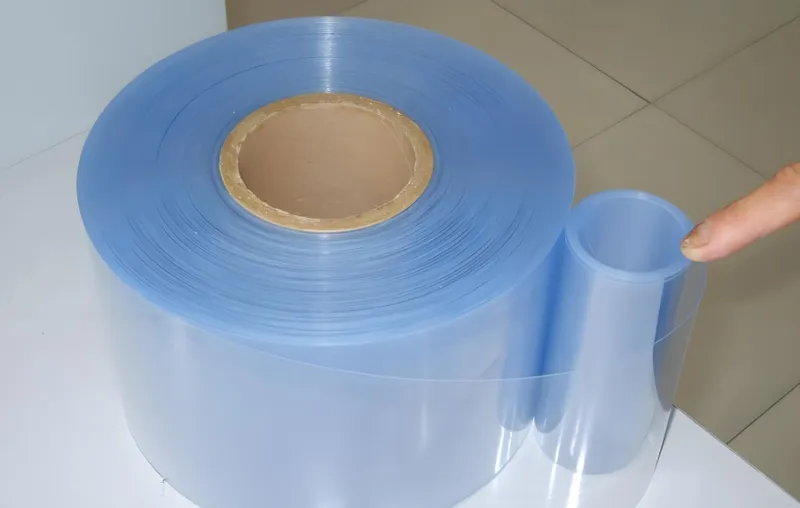
Thermoforming Materials
-
Polypropylene (PP): Flexible, used in packaging.
-
Polyethylene Terephthalate (PET): Clear, for trays.
-
Polyvinyl Chloride (PVC): Rigid, for signage.
Uniform sheet thickness is vital to avoid weak spots.
Injection Molding Materials
-
ABS: Tough, for electronics.
-
Polycarbonate (PC): Strong, for lenses.
-
Nylon: Durable, for gears.
Flow and shrinkage properties must align with mold design.
Both processes use identical materials.False
Thermoforming is sheet-limited; injection molding uses pellets with broader options.
Material choice affects part quality.True
Each material brings unique traits like strength or flexibility.
What Design Considerations Should I Keep in Mind?
Good design prevents defects and ensures functionality.
Thermoforming needs draft angles and uniform thickness; injection molding requires consistent walls and ejection-friendly angles.
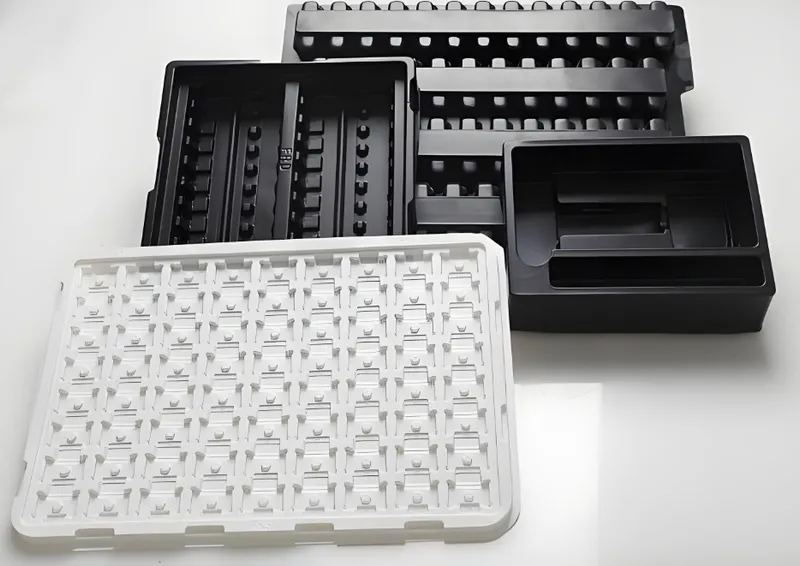
Thermoforming Checklist
-
Draft Angles5: 1–5° for demolding.
-
Thickness: Even to prevent thinning.
-
Radii: ≥0.125 inches to avoid tears.
Injection Molding Checklist
-
Wall Thickness: 0.080–0.120 inches, uniform.
-
Draft Angles: 1–2° for ejection.
-
Ribs: Depth ≤ 3x wall thickness.
Thermoforming undercuts are free.False
They require complex tooling, raising costs.
Uniform walls prevent injection molding flaws.True
Even thickness avoids warping or sink marks.
How Do I Decide Between Thermoforming and Injection Molding?
A clear framework guides your choice.
Weigh part size, volume, complexity, and cost to pick the right process.

Decision Guide
-
Size: Thermoforming for parts >1m².
-
Volume: Thermoforming <5,000; injection molding >5,000.
-
Complexity: Injection molding for tight tolerances (<0.005 inches).
-
Budget: Thermoforming for low startup; injection molding for scale.
Thermoforming always wins for low volumes.False
Injection molding may suit small, complex parts even in low runs.
Injection molding is best for precision.True
Its accuracy is unmatched for detailed parts.
What Related Technologies Should I Know?
Context matters—other processes and steps influence your choice.
Upstream: material production and mold-making; downstream: assembly and finishing.

Upstream
-
Material Prep: Sheets for thermoforming, pellets for injection molding.
-
Mold Creation: CNC or 3D printing.
Downstream
-
Assembly: Joining parts.
-
Finishing: Painting, polishing.
Alternatives
-
Blow Molding6: Hollow items like bottles.
-
Rotational Molding: Large, seamless parts.
These are the only plastic processes.False
Blow and rotational molding offer other solutions.
Conclusion
Thermoforming suits large, simple parts with lower volumes and quick setup, while injection molding excels at small, complex parts with high precision and cost efficiency at scale. Assess your part’s size, complexity, volume, and budget to choose wisely.
-
Discover insights on selecting the right manufacturing process for your plastic parts based on specific project requirements. ↩
-
Explore the benefits of thermoforming to understand its applications and how it can suit your project needs. ↩
-
Learn about injection molding's precision and scalability, crucial for producing complex parts in various industries. ↩
-
Learn how selecting the right materials can significantly impact the efficiency and quality of manufacturing processes. ↩
-
Understanding draft angles can enhance your design skills and improve product manufacturability. ↩
-
Discover the Blow Molding process and its applications in creating hollow items like bottles. ↩



